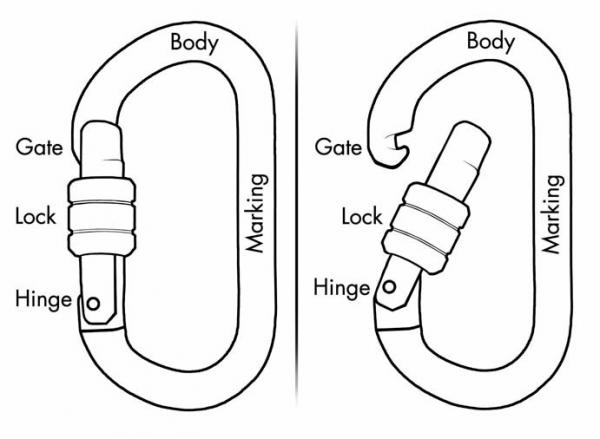
© SATRA Technology Centre. Reproduction is not permitted in any form without prior written permission from SATRA.

Karabiners and fall protection connectors
When undertaking an activity at height, appropriate fall arrest equipment should be used.

Karabiners are key components used to connect parts of the fall protection system in a flexible but safe and secure way.
There are two main areas of usage of karabiners as personal protective equipment (PPE) in Europe. The first of these is the industrial environment, and here EN 362 is applied. The second is for recreational climbing, which is covered by EN 12275. The standards are slightly different, but have much in common.
There are various design tests. One is to check that the karabiner is large enough to hold one rope safely behind the gate while another is inserted. Other tests make sure that the gate is wide enough for its intended purpose, and that it is free of burrs that could damage the ropes or injure the user. There are also innocuousness requirements to guard against the presence of chemicals that may irritate or harm the user.
Both standards aim to make it impossible for the user to believe that the gate has been locked, when it has been inadvertently left open. The standards cover this either by requiring that the gate locks automatically, or that a deliberate action is needed to lock it. Both automatic and manual gates require at least two deliberate actions to open them, reducing the chances of accidental opening.
For EN 362, the static (tensile) strength requirements are for the karabiner to withstand typical loads of 20 kN in the main direction of force for three minutes. If this weight seems high when compared to a person with a weight around 1 kN (roughly 16 stone), it should be noted that the dynamic forces as a fall is arrested can be much higher than the dead weight of the load alone. In addition, the requirement includes a factor of safety of more than 2.5 (assuming a maximum arrest force of 6 kN is allowable in a system).

The main components of a karabiner shackle.
There are also some strength tests to ensure the gate can withstand lower forces such as side loads (1.0 or 1.5 kN, depending on the direction) and not allow the rope to be released when the gate is locked, while still allowing the gate to be opened when necessary. This is assessed by measuring gate movement while the load is being applied and gate function after the load is released.
Corrosion can affect karabiners as they are often used in external and potentially harsh environments. Corrosion can weaken the karabiner, affecting the moving parts, so this needs to be tested. This is done by placing the karabiner in a corrosive atmosphere of warm saltwater mist for 48 hours (EN 362). A visual assessment is carried out to determine if corrosion has taken place. At SATRA we can also assess the static strength of the karabiner after this procedure, to better judge if the karabiner has been affected by the corrosive atmosphere.
Further information on SATRA's PPE certification and testing services is available at www.satra.com/ppe
How can we help?
15 PER CENT DISCOUNT ON FIRST SATRA TEST — please click here.
Please email ppe@satra.com for more information on testing karabiners and other fall protection equipment.


 EN
EN ZH
ZH